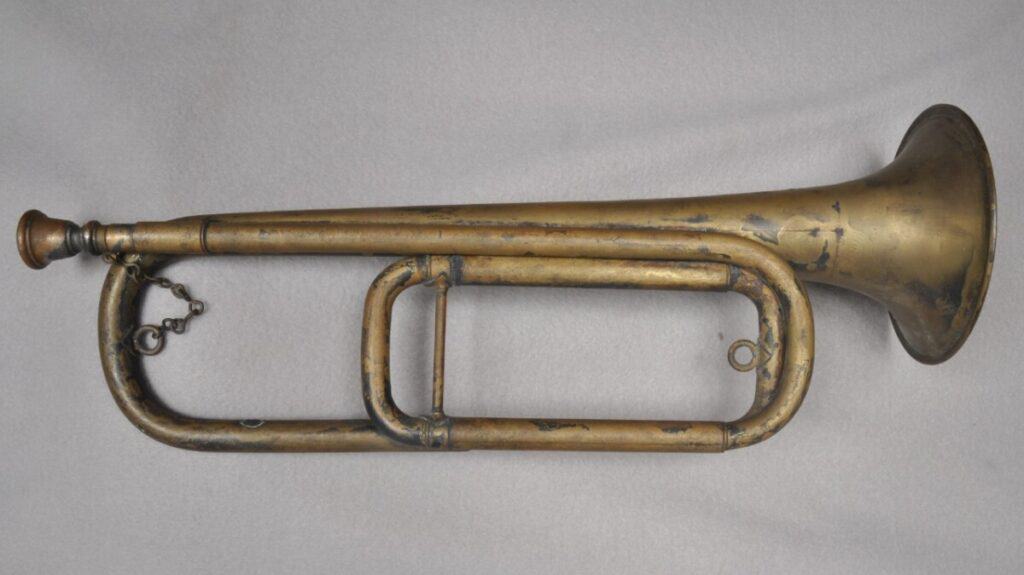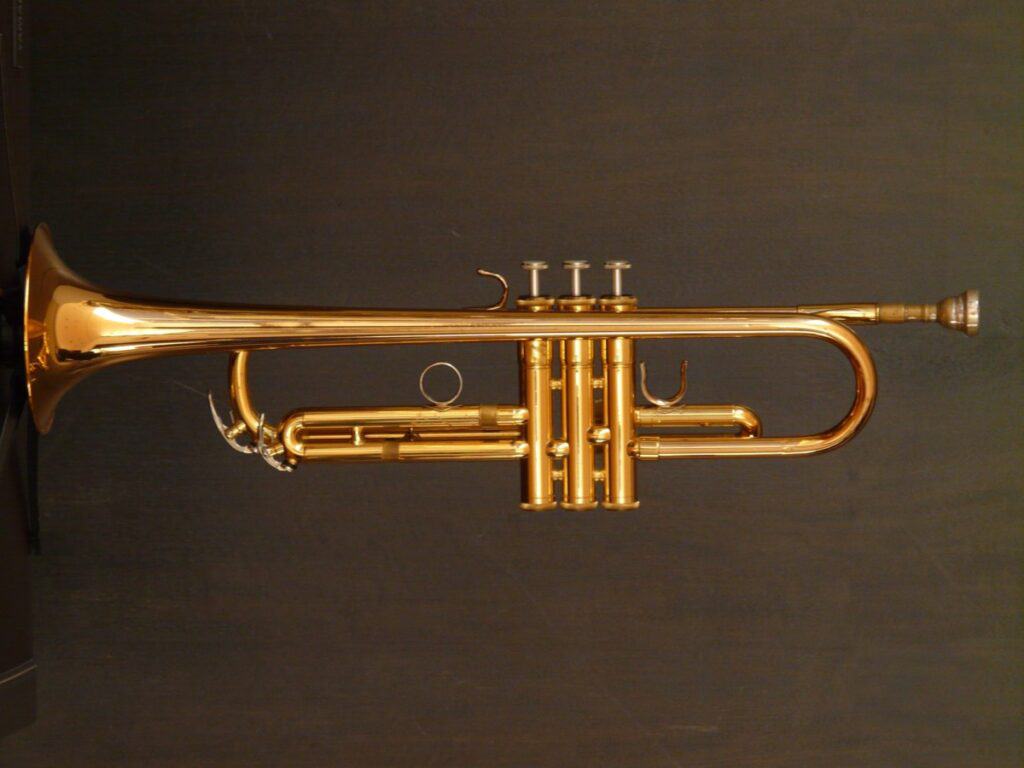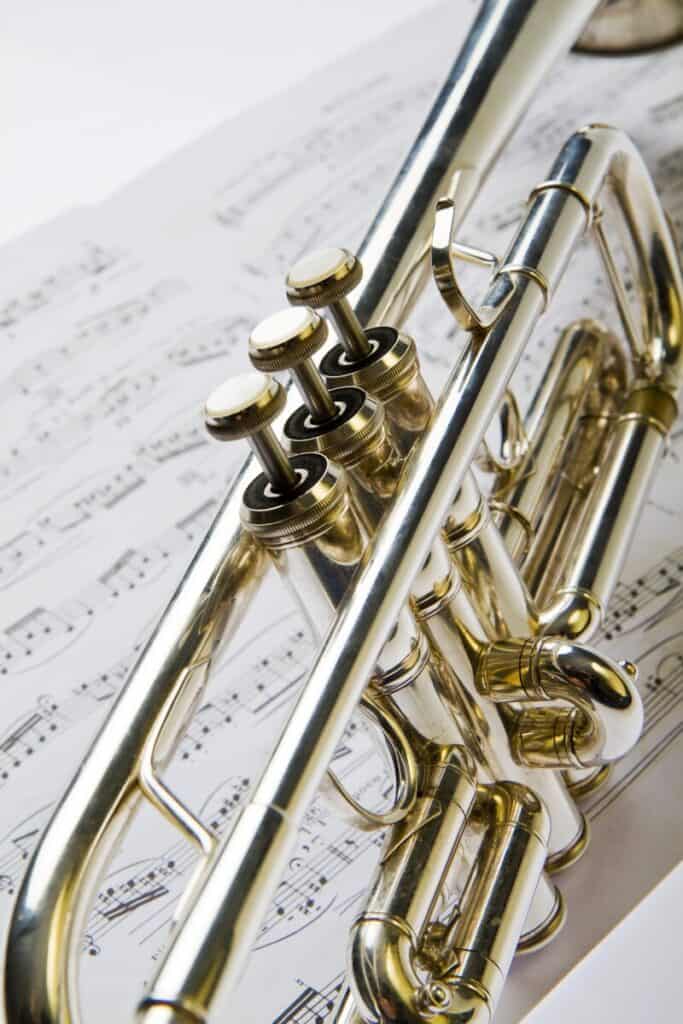This post contains affiliate links. We earn commissions if you purchase products from retailers after clicking on a link from our site. As an Amazon Associate, we earn from qualifying purchases.
The trumpet and the bugle have long interwoven histories that are dynamic and complex. But, if someone were to ask you today what the difference was, would you be able to answer them?
In modern terms, the primary difference between a bugle and a trumpet is that the bugle is a horn with a static tube length, while the modern trumpet has adjustable tube length via 3 valves that open and close access to pipes that lengthen or shorten the trumpet air flow.
That sounds complicated. Once you see a couple pictures, though, you’ll be able to follow along. Understanding the reason why a trumpet has valves and a bugle does not requires understanding a bit about sound physics. Don’t worry, I am only a hobbyist musician and so I don’t have the understanding to get too complicated. So I’ll keep it simple. I’ll also be nice and put it after the more obvious differences.
Differences Between the Trumpet and Bugle
The bugle and trumpet are often in the same key and they look very similar, but there are some very important key differences. Let’s take a look.
Let’s take a look at what is different about the two instruments.
Physical Differences
The Bugle

By the way, looking for recording equipment and musical instruments? Check out Sweetwater.com for microphones, monitors, audio interface or any other recording gear that you could ever need. (Affiliate Link)
You can see the bugle is a fairly simple instrument, it’s comprised of a pipe that starts with a mouthpiece (where the player puts their lips and buzzes to produce the sound), which is inserted into the lead pipe. You’ll notice a chain that’s actually attached to the mouthpiece.
If you play the trumpet in band and you lose your mouthpiece, it’s not the end of the world. But if a bugler loses their mouthpiece this can be a serious issue since the bugle has military purposes.
The chain that’s attached to the mouthpiece is affixed to a loop on the body of the instrument so that the mouthpiece will have a much harder time getting lost.
Unlike a trumpet, the bugle is one continuous tube that spirals around. Turns out that this isn’t a requirement, the spiraling of the tubing is only to save space and to be more convenient to carry. You would get the same sound (essentially) if you rolled out the entire instrument. The tubing flares out into a bell shape at the end. The bell is very important in projecting the sound.
Although the pictured bugle doesn’t have one, bugles can come with a “water key”, more commonly known by trumpeters as the spit valve.
Another thing you’ll notice on some bugles is a tuning slide–very similar to the trumpet, the bugle can be tuned by pulling or pushing in a tuning slide that adjusts the length of the tubing very slightly.
Some bugles have an expansive enough tuning slide that they can drop an entire note, which makes it slightly easier to play higher notes.
The bugle pictured has no valves, and usually when someone says bugle they mean the type of bugle with no valves. Some bugles actually do have valves. This expands the range of notes that can be played.
You may have noticed that this particular bugle has rings on both sides facing each other. These rings are too small for fingers– so what are they? These are called, as best as I could research, “tabard rings.” (source), which are essentially for tying decorative flare to the bugle. You can see a few examples on Pinterest if you search for “bugle wrap”.

The Trumpet

The trumpet is a much more complicated instrument. You can see that it follows the same type of principle of being a pipe that spirals around and eventually ends up in a flared bell shape. However, there are some more lengths of pipe interconnected into a 3-valve system, as you can see in this picture.
These valves change the length of the tube. Changing the length of the tube changes the fundamental note of the trumpet and therefore its harmonic series.
In normal human speak, pressing the valves allows you to play more notes. To be precise, you can play all 12 notes in our music system by pressing down the valves.
You can also see two strange triggers on the left side of the image. These are called water keys (or just spit valves to the initiated). Because condensation and spit gets trapped in the tube, it’s helpful to have a valve you can open to release the spit. It’s also kind of gross but wind instrumentalists are completely immune to being grossed out by it. It’s just as natural as breathing… so to speak.
You can also see 3 different rings or hooks on the instrument.
The ring on the left side of the image on the bottom of the trumpet is for the left hand to grip and wear (like you would a ring). The weight of the instrument is balanced by the usage of this ring. It’s not mandatory–but does help with a firmer grip.
Furthermore, this ring is used for pulling out this valve for certain notes that get out of tune when played.
The hook on the bottom right of this image is for the left thumb. The player holds the trumpet with the thumb through this hook and the fingers wrapping around the 3 valves in the center with the (typically ring finger) going through the ring on the left.

This picture shows a closeup of the top of the trumpet and you can see the hook on the lead pipe of the instrument. This hook is meant for playing and holding the instrument with right hand when you are doing something else with your left hand (such as operating a mute).
Although you can play and hold the trumpet with your right hand, it’s not designed for this–it’s only really designed for temporary holding.
This picture also gives you a better look at the additional tubes on the trumpet. The air in this instrument goes through these tubes as you push down the three valve keys in the center of the instrument. Different combinations of these valves give you different notes.
How Many Notes Can the Bugle and the Trumpet Play?
Bugle
The primary notes a no-valve bugle can play:
C4, G4, C5, E5, G5, C6
You can play other notes below and above these with some difficulty. Frankly, C6 is hard enough for most people.
Trumpet
The trumpet can play all 12 notes of our music system over 3+ octaves. That’s over 36 total pitches.
Starting at F#3 all the way to G6
Where The Instrument Is Used
Over the years the roles of these instruments have varied. Today, the two instruments have very different purposes.
Bugle
Today the bugle is almost exclusively in military, scout, or other ceremonial situations. The U.S. Army for instance, still uses bugle calls for many purposes including waking up, mealtimes, and going as a signal for end of duty. You can see more recent info about some of the calls used here on the army’s website.
Parades, ceremonies, rituals–the bugle, to this day, plays a role carried down from tradition. To signal, to announce, to warn.
Because the bugle has a very limited range of notes, it is not really seen in any kind of musical capacity outside of these ceremonies.
Another famous example of where the bugle is played is Taps in Arlington Cemetery. You can see more history behind this at their website here.
Trumpet
Because the bugle and the trumpet are in the same evolutionary design, the trumpet can be used as a bugle if you don’t press any of the valves. The same note interval is accessible to the trumpet. The trumpet can be used in ceremonies where a traditional bugle is not available. Which is most of the time for most people since bugles are a very specific instrument.
Trumpets however are primarily used in musical settings–the trumpet is a full-fledged serious instrument. In fact it’s considered a very difficult instrument to play (you can learn why here in my post where I go into detail about it).
The trumpet is played in traditional orchestral music, dozens of varieties of jazz, and even modern pop songs.
Are Trumpets Easier To Play Than Bugles?
It may seem that because the trumpet has buttons that it is easier to play. While a trumpet and a bugle may have some differences in being physically different to play, fundamentally the instruments are very similar, a trumpet plays the same notes as the bugle with no buttons pressed. To add more notes, the trumpet was given 3 valves–thus, the trumpet is more of an extension of the bugles capabilities.
So, the answer is no, the trumpet is actually a more difficult instrument because you can do more with it. It’s not a quite perfect answer– A good analogy would be if it’s harder to use a screwdriver or a multi-use tool. Both instruments have a different purpose, but ultimately you can do much more with the trumpet.
What Key Is a Bugle In?
Most Bugles are in the key of Bb. But bugle music is transposed and written in the key of C.
So the notes that you will see in bugle music are:
C, G, C, E, G, C
However, since the bugle is in the key of Bb, if you went to a piano and matched those pitches, you would see the bugle is actually playing:
Bb, F, Bb, D, F, Bb
This is very similar to the trumpet. Most trumpets are in the key of Bb and follow the same pattern.
Understanding How A Horn Works
So, why is it you can play only a few notes with the bugle and way more notes with the trumpet? I’ll dig into this for the curious of you out there.
In order to get what the big deal is between the bugle and the trumpet, it helps to understand a little bit of how the trumpet and the bugle works–even if just in practical terms.
Let’s remember our good friends the trombones. If you notice, trombones change the pitch of their instrument by pulling out the trombone slide. The further the trombone player pulls out the slide, the lower the note becomes. On the other hand, the more the trombone player pulls IN the slide, the higher the trombone sound becomes as the trombone’s length is decreased.
Critically important to understand is that trombones have multiple positions. Which is just a point on the trombone that the player memorizes so they can play the same note. The real trick is that trombones can play the multiple notes with the same position.
This is exactly the same principles as the bugle and also applies to the trumpet.
A horn at a specific length of tubing has a primary resonance frequency called the fundamental (which is actually too low for our lips to really play). However, the horn can also resonate at multiple other harmonics.
This means that one specific length of tubing can play multiple notes because it can resonate at multiple frequencies.
For example, on a bugle, which is in the key of Bb, can play C, G, C, E, G, and C. These notes are in the harmonic series of the fundamental note of the bugle. Because the bugle is a fixed length, these are all the notes the bugle will resonate to! You can kind of play in between the notes but they won’t sound good because the bugle’s length will only resonate at those notes.
The trumpet on the other hand can resonate at all frequencies because you can open and close the valves to extend or contract the tubing on the instrument. There are only 6 combinations of valves, though. To play all 12 notes of the chromatic scale the trumpet player has to go up and down the harmonic series.
In other words, the trumpet will resonate at the same pitches as the bugle without pressing the valves down, C, G, C, E, G. If, however you press the first valve down, the trumpet’s tubing has been changed and now can resonate at Bb, F, Bb, D, F, and so on.
What is the difference between playing the bottom C and the top C if you are using the same fingerings?
The players lips. The player has to buzz faster in order to produce the vibration necessary for the trumpet to resonate.
Summary
Anyway. That’s kind of a tangent. But it’s kind of fun for me to see the differences between the two instruments and why they act the way they do. Hope you learned something, today.
